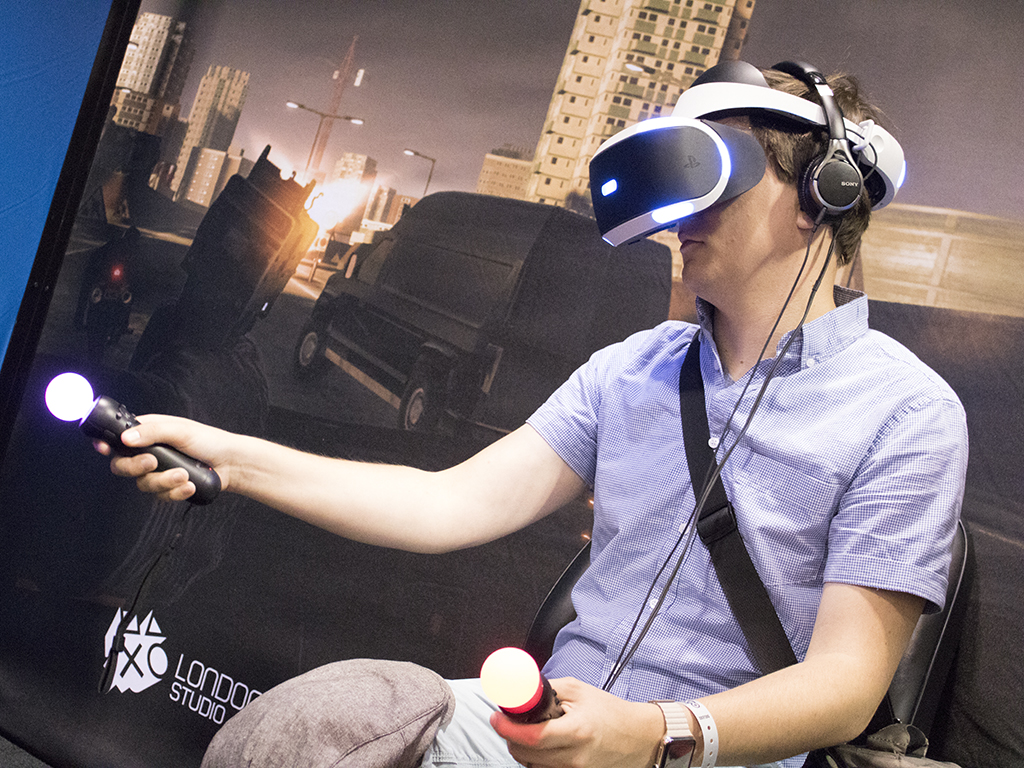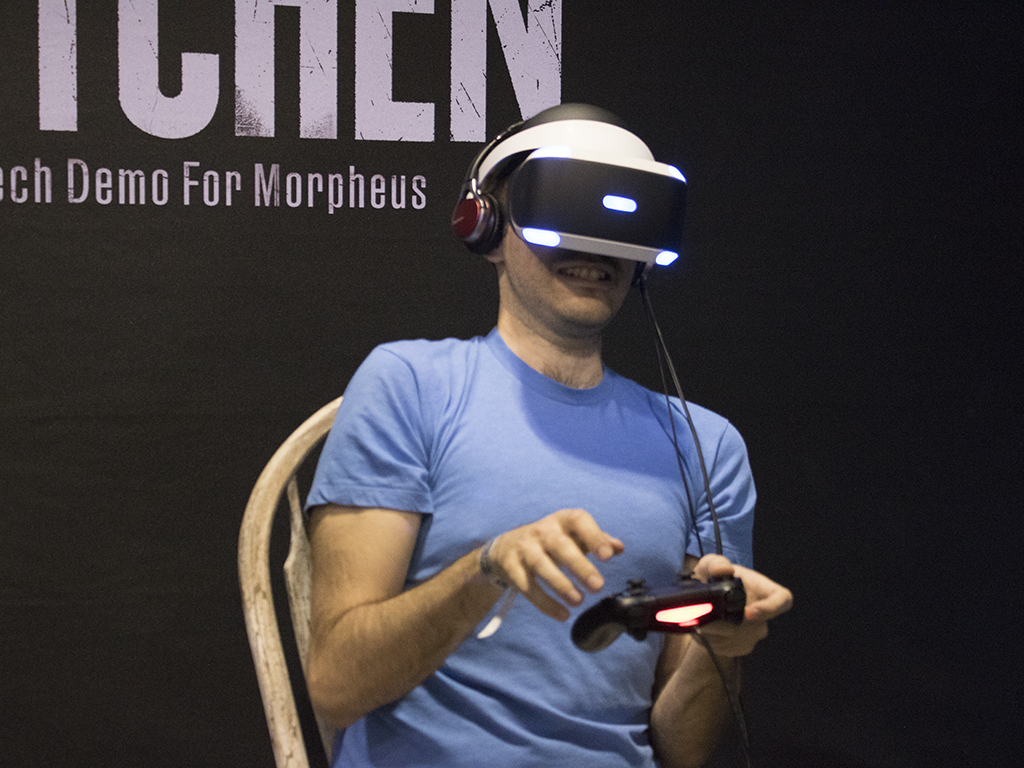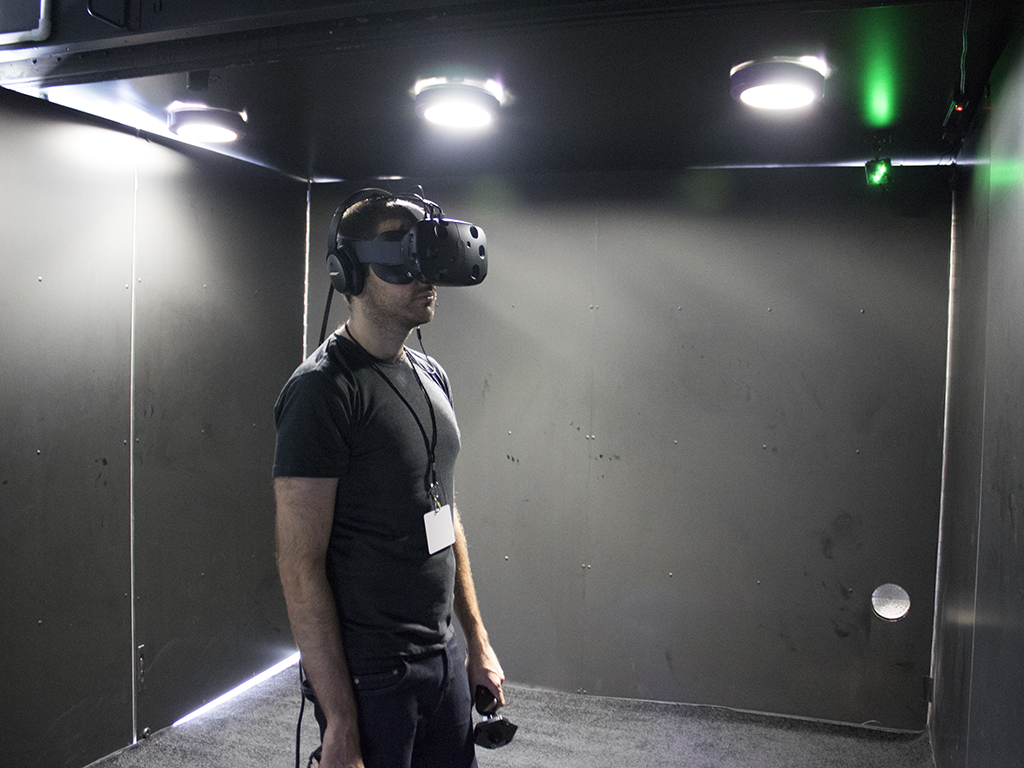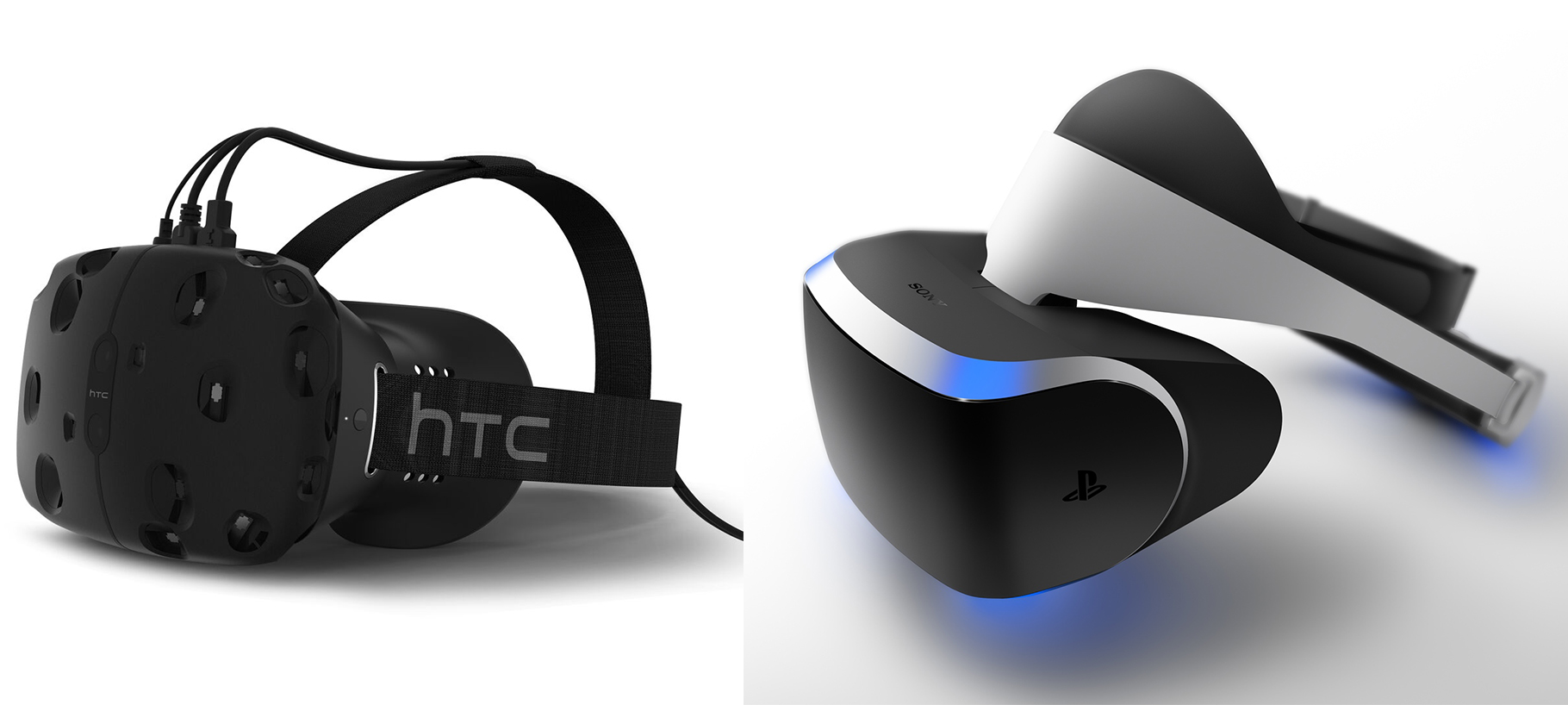
Welcome to Tête-à-Tête, a series where two of our writers converse on interesting topics in the mobile landscape — through chat. Think of it as a podcast for readers.
After a long break, this week we have Patrick O’Rourke and Igor Bonifacic discuss their experience trying out HTC’s Vive and Sony’s Project Morpheus (now known as PlayStation VR) virtual reality (VR) headset and whether or not anyone should really even care about virtual reality in the first place.
PlayStation VR: Low-resolution visuals still plague the device’s immersion factor
Patrick O’Rourke: In 2013 it seemed as if every major technology company was announcing their own version of virtual reality. Back then I thought the entire trend was a very expensive and elaborate mistake. Didn’t we try this already in the late 80s/early 90s and realize VR is fodder for (usually) bad Sci-Fi movies?
Little did I know how wrong I really was. VR isn’t the entire future of gaming (which is a good thing), but it will likely play a significant role in the medium moving forward, as well as how we communicate in general (I’m looking at you with that one Facebook).
I’ve basically tried them all: PlayStation VR, Oculus, Gear VR, Google Cardboard and most recently, HTC’s Vive. Each device has its own individual strengths and weaknesses, but HTC’s Vive is by far the most impressive in terms of motion tracking capabilities, available demos, and perhaps most importantly, in the context of comparing the device to any other form of VR I’ve used so far.
But lets start off with the lesser VR headset – Sony’s PlayStation VR. I’ve tried the device on one other occasion during E3 2013 and was relatively impressed with what I experienced. At the time two demos were shown off; one that had the player leaning left and right in order to louge down a busy road on a skateboard, and another where you punched a knight in the face using the PlayStation Move’s controllers. Neither experience was really what you might expect from a full game built around PlayStation VR, but the demos were nevertheless still entertaining.
At Fan Expo 2015 in Toronto I was able to test out Sony’s latest PlayStation VR offerings and my reaction to both experiences was similar to my previous impressions (I think Igor follows my train of though on this one as well). One less than stellar demo created by Capcom called Kitchen – which I have a feeling could eventually have something to do with the Resident Evil series – was relatively non-interactive. In the demo the player is strapped to a chair while a scary demonic girl (who looks like she was pulled straight from the Ring horror movie series) kills your companion by brutally stabbing them, and then proceeds to terrorize the player in a variety of ways.
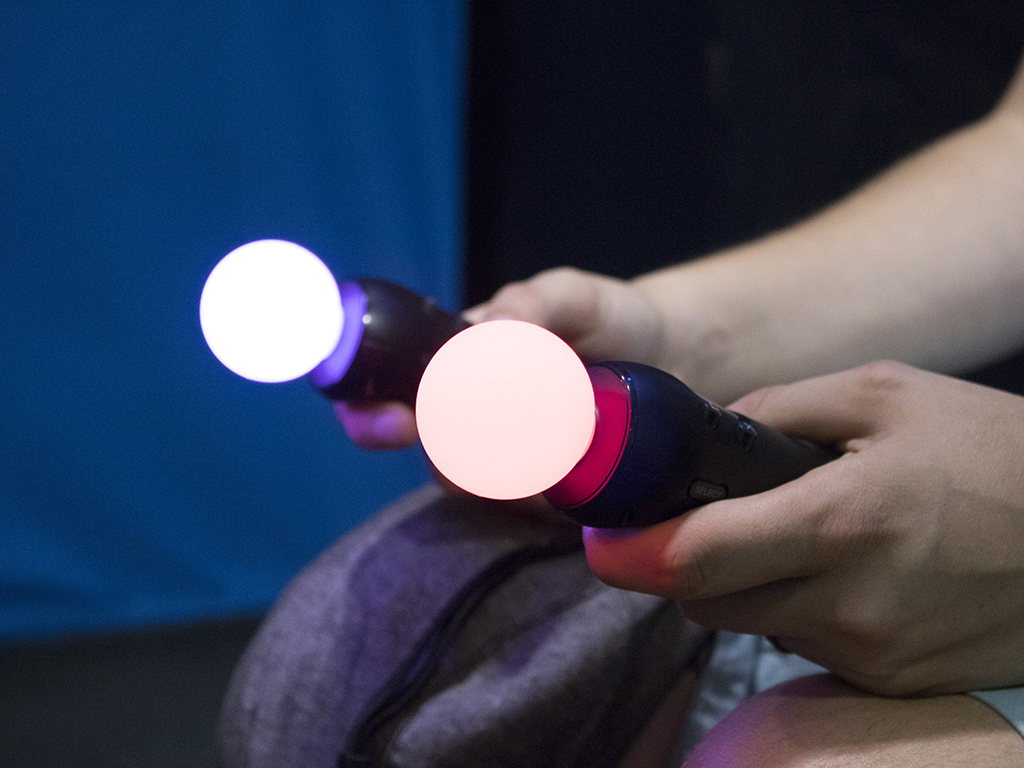
PlayStation VR works with Sony’s WiiMote-like PlayStation Move controllers. Image credit: Igor Bonifacic
I’m not easily frightened and a busy convention centre show floor definitely isn’t the appropriate setting to delve into an experience like Kitchen. I found myself audibly laughing at most of the game’s efforts to scare me. While I firmly believe kitchen is a vertical slice pulled from a larger video game currently in development, what I experienced wasn’t very impressive. To me VR’s strength stems from giving the player an unprecedented level of interactivity, and this isn’t what Kitchen offered.
The other PlayStation VR demo I experienced at Fan Expo was significantly more impressive, but still forced the player to remain relatively stationary, although this seems to be a limitation of PlayStation VR’s motion tracking capabilities. London Heist has the player shooting an automatic weapon out the window of a moving vehicle while a Jason Statham lookalike spouts witty one-liners.
This demo is simple and straightforward, but it’s still interesting to see how a traditional first-person shooter could work within the confines of VR. The most interesting part of the experience is getting the hang of the precise movement required to grab an additional ammo clip for your weapon and then load it into a gun. The clip needs be picked up on a specific angle and then turned precisely in order to fit into the weapon (just as I imagine it would in the real world).
My biggest issue with PlayStation VR is that the headset’s resolution related problems still haven’t been solved (and at this point might never be). Games look blurry, pixelated and generally unimpressive, which I found ruined PlayStation VR’s immersion factor. This is likely due to the PS4’s lack of processing power, especially when compared to the ultra high-end PCs that power VR headsets like Oculus Rift and Vive.
Igor Bonifacic: For a variety of reasons, Playstation VR feels like a non-starter for me. Like you mentioned, the resolution issue was front and centre as I tried the headset for the first time. So much of the narrative of this current console generation has been built around how much more powerful the PS4 is over the Xbox One (even when those performance gains are hard to notice once you’re caught up in the moment-to-moment gameplay of a cross-platform game), but ask the PS4 to render the same scene multiple times, like the Playstation VR does, and the system comes off looking weak.
The only demo I had a chance to play at Fan Expo was the Kitchen one you mentioned, and there the blurriness of the images I was shown was perhaps the best indication that virtual reality and home consoles may not be the best fit. Compared to the crispness of several games that have graced Sony’s platform in recent months, Kitchen — vertical slice or not — looked like a major step back. That may not have been such an issue if it was a fun experience. Unfortunately, I was only asked to complete one relatively minor gameplay interaction, so taking in the graphics (and noticing the device’s lack of fidelity) was what I ended up doing throughout most of the experience.
As someone who loves titles like Bloodborne, games that ask players bring a certain level of mechanical competence to the proceedings, I also don’t see my favourite gameplay experiences translating to virtual reality. Even watching you play some of the other demos it looked like they weren’t fully fleshed out (which they obviously weren’t) and depended a lot on gimmicks. Granted, I’m probably being overly harsh here. Between studios like Naughty Dog and Media Molecule, Sony probably has some of the world’s most capable game designers creating experiences for Morpheus.
Moreover, having done some research since the event, I’ve found games like Keep Talking and Nobody Explodes that look like they use the capabilities and limitations of virtual reality to great effect. Still, what has me most worried is that Sony hasn’t said anything about the eventual price of the unit. Ultimately, what makes any game console compelling are the games developers create for it, but a system needs a certain amount of scale before publishers are comfortable investing money into it. If the past couple of generations have proved anything, it’s that an accessory like the Playstation VR needs to be packaged with the console; publishers and developers need to know there’s an audience for their games.
HTC Vive: Surprise, Vive is still the most impressive VR headset out there
Patrick: What’s scary about the HTC Vive is that so little is known about it. We’re two months away from the device’s release and we still have no information related to its price, launch titles, or even important technical specifications like screen resolution (although one thing is for sure; the Vive’s screen is a higher resolution than PlayStation VR). Some rumours peg screen resolution at 1080×1200, although as far as I know, nothing has been confirmed.
But even with everything I’ve said above in mind, HTC Vive is still the most impressive VR headset coming to market.
The big difference between HTC’s Vive and other headsets I’ve used is the device actually tracks where the user is in the real world, giving you physical boundaries that can be altered depending on how large a room is (the maximum coverage area is 457cm or 15-feet). While I haven’t experienced vertigo with any VR headset I’ve tested out in the past, research shows the wearer’s actual ability to move around in the physical world, and then see this interaction represented in a virtual space, negates the motion sicknesses that accompany’s VR for many people.
The first Vive demo I checked out at Best Buy’s Wearable Tech Expo had me walking around a sunken ship and interacting with fish, as well as other aquatic life. While relatively simple, the Vive’s three-dimensional display was very apparent as I reached out attempting to pet various forms of aquatic life. The Vive’s 3D display gives players a sense of space and depth I haven’t experienced before in virtual reality, as well as an advantage over the reining king of VR headsets, Oculus.
Next it was on to a demo tasking me with listening to a robotic voice in order to create soup. This is when I realized how accurate the Vive’s two controllers (which amusingly feel very similar to PlayStation Move’s input devices) really are, allowing me to pin-point specific ingredients with ease and toss them into a large cooking pot.
But it wasn’t until the Vive’s final two demos, one created by Valve that featuring elements of the Portal universe, and an art-focused three-dimensional drawing demo, that the device absolutely blew me away. While Vive’s Portal demo isn’t particularly mind-blowing or even that interactive, it’s the first example I’ve seen so far of what a full-fledged VR game might look like (Portal fans will definitely find a lot to enjoy here as well).
Finally there’s Tiltbrush, a demo allowing users to draw three-dimension, fluorescent creations across a black canvas. This demo was incredible and the video above does a better job of showing off what the experience is like better than I ever could. But basically, imagine the ability to draw 3D pictures around you – it’s incredibly cool.
Overall my experience with the Vive was breathtaking and my only issue was its sponge lining is a sweat magnet. This is not a good thing when when you’re playing it in 30 degree weather (it was a rather disgusting experience).
Igor: The Vive was definitely one of the most impressive tech demos I’ve seen in my short career. I have a fear of heights and the Portal demo had my lizard brain completely fooled that I was about to fall.
Still, there’s one main issue I can see cropping up with the Vive.
Like Playstation VR, the obvious one is price. I didn’t take a detailed look at the computer HTC had powering the demo, but it looked like a dual graphics card setup. Between the headset itself and the system that will be required to power it, it’s possible it will cost more than $1000 to get a decent Vive setup up and running.
At that point the same issue that Playstation VR will likely come up against—whether developers and publishers decide there’s enough of a install base to make creating experiences for it worthwhile—comes up. With the Vive I can see that issue being especially thorny with how poor HTC’s financials have been over the past couple of quarters.
MobileSyrup may earn a commission from purchases made via our links, which helps fund the journalism we provide free on our website. These links do not influence our editorial content. Support us here.

